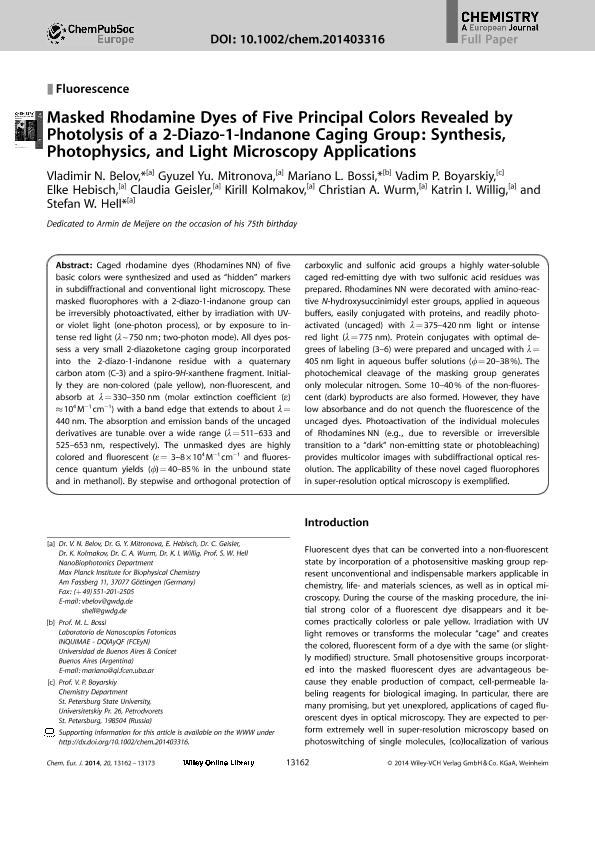Mostrar el registro sencillo del ítem
dc.contributor.author
Belov, Vladimir N.
dc.contributor.author
Mitronova, Gyuzel Yu.
dc.contributor.author
Bossi, Mariano Luis

dc.contributor.author
Boyarskiy, Vadim P.
dc.contributor.author
Hebisch, Elke
dc.contributor.author
Geisler, Claudia
dc.contributor.author
Kolmakov, Kirill
dc.contributor.author
Wurm, Christian A.
dc.contributor.author
Willig, Katrin I.
dc.contributor.author
Hell, Stefan W.
dc.date.available
2018-01-03T19:03:50Z
dc.date.issued
2014-09
dc.identifier.citation
Belov, Vladimir N.; Hebisch, Elke; Mitronova, Gyuzel Yu.; Bossi, Mariano Luis; Boyarskiy, Vadim P.; Geisler, Claudia; et al.; Masked Rhodamine Dyes of Five Principal Colors Revealed by Photolysis of a 2-Diazo-1-Indanone Caging Group: Synthesis, Photophysics, and Light Microscopy Applications; Wiley VCH Verlag; Chemistry- A European Journal; 20; 41; 9-2014; 13162-13173
dc.identifier.issn
0947-6539
dc.identifier.uri
http://hdl.handle.net/11336/32179
dc.description.abstract
Caged rhodamine dyes (Rhodamines NN) of five basic colors were synthesized and used as “hidden” markers in subdiffractional and conventional light microscopy. These masked fluorophores with a 2-diazo-1-indanone group can be irreversibly photoactivated, either by irradiation with UV- or violet light (one-photon process), or by exposure to intense red light (λ∼750 nm; two-photon mode). All dyes possess a very small 2-diazoketone caging group incorporated into the 2-diazo-1-indanone residue with a quaternary carbon atom (C-3) and a spiro-9H-xanthene fragment. Initially they are non-colored (pale yellow), non-fluorescent, and absorb at λ=330–350 nm (molar extinction coefficient (ε)≈104 M−1 cm−1) with a band edge that extends to about λ=440 nm. The absorption and emission bands of the uncaged derivatives are tunable over a wide range (λ=511–633 and 525–653 nm, respectively). The unmasked dyes are highly colored and fluorescent (ε= 3–8×104 M−1 cm−1 and fluorescence quantum yields (ϕ)=40–85 % in the unbound state and in methanol). By stepwise and orthogonal protection of carboxylic and sulfonic acid groups a highly water-soluble caged red-emitting dye with two sulfonic acid residues was prepared. Rhodamines NN were decorated with amino-reactive N-hydroxysuccinimidyl ester groups, applied in aqueous buffers, easily conjugated with proteins, and readily photoactivated (uncaged) with λ=375–420 nm light or intense red light (λ=775 nm). Protein conjugates with optimal degrees of labeling (3–6) were prepared and uncaged with λ=405 nm light in aqueous buffer solutions (ϕ=20–38 %). The photochemical cleavage of the masking group generates only molecular nitrogen. Some 10–40 % of the non-fluorescent (dark) byproducts are also formed. However, they have low absorbance and do not quench the fluorescence of the uncaged dyes. Photoactivation of the individual molecules of Rhodamines NN (e.g., due to reversible or irreversible transition to a “dark” non-emitting state or photobleaching) provides multicolor images with subdiffractional optical resolution. The applicability of these novel caged fluorophores in super-resolution optical microscopy is exemplified.
dc.format
application/pdf
dc.language.iso
eng
dc.publisher
Wiley VCH Verlag

dc.rights
info:eu-repo/semantics/openAccess
dc.rights.uri
https://creativecommons.org/licenses/by-nc-sa/2.5/ar/
dc.subject
Bioconjugation
dc.subject
Fluorescence
dc.subject
Photolysis
dc.subject
Rhodamines
dc.subject.classification
Otras Ciencias Químicas

dc.subject.classification
Ciencias Químicas

dc.subject.classification
CIENCIAS NATURALES Y EXACTAS

dc.title
Masked Rhodamine Dyes of Five Principal Colors Revealed by Photolysis of a 2-Diazo-1-Indanone Caging Group: Synthesis, Photophysics, and Light Microscopy Applications
dc.type
info:eu-repo/semantics/article
dc.type
info:ar-repo/semantics/artículo
dc.type
info:eu-repo/semantics/publishedVersion
dc.date.updated
2017-12-27T15:21:30Z
dc.journal.volume
20
dc.journal.number
41
dc.journal.pagination
13162-13173
dc.journal.pais
Alemania

dc.journal.ciudad
Weinheim
dc.description.fil
Fil: Belov, Vladimir N.. Max Planck Institute for Biophysical Chemistry
; Alemania
dc.description.fil
Fil: Mitronova, Gyuzel Yu.. Max Planck Institute for Biophysical Chemistry
; Alemania
dc.description.fil
Fil: Bossi, Mariano Luis. Consejo Nacional de Investigaciones Científicas y Técnicas. Oficina de Coordinación Administrativa Ciudad Universitaria. Instituto de Química, Física de los Materiales, Medioambiente y Energía. Universidad de Buenos Aires. Facultad de Ciencias Exactas y Naturales. Instituto de Química, Física de los Materiales, Medioambiente y Energía; Argentina
dc.description.fil
Fil: Boyarskiy, Vadim P.. St. Petersburg State University; Rusia
dc.description.fil
Fil: Hebisch, Elke. Max Planck Institute for Biophysical Chemistry
; Alemania
dc.description.fil
Fil: Geisler, Claudia. Max Planck Institute for Biophysical Chemistry
; Alemania
dc.description.fil
Fil: Kolmakov, Kirill. Max Planck Institute for Biophysical Chemistry
; Alemania
dc.description.fil
Fil: Wurm, Christian A.. Max Planck Institute for Biophysical Chemistry
; Alemania
dc.description.fil
Fil: Willig, Katrin I.. Max Planck Institute for Biophysical Chemistry
; Alemania
dc.description.fil
Fil: Hell, Stefan W.. Max Planck Institute for Biophysical Chemistry
; Alemania
dc.journal.title
Chemistry- A European Journal

dc.relation.alternativeid
info:eu-repo/semantics/altIdentifier/doi/http://dx.doi.org/10.1002/chem.201403316
dc.relation.alternativeid
info:eu-repo/semantics/altIdentifier/url/http://onlinelibrary.wiley.com/doi/10.1002/chem.201403316/abstract
Archivos asociados
